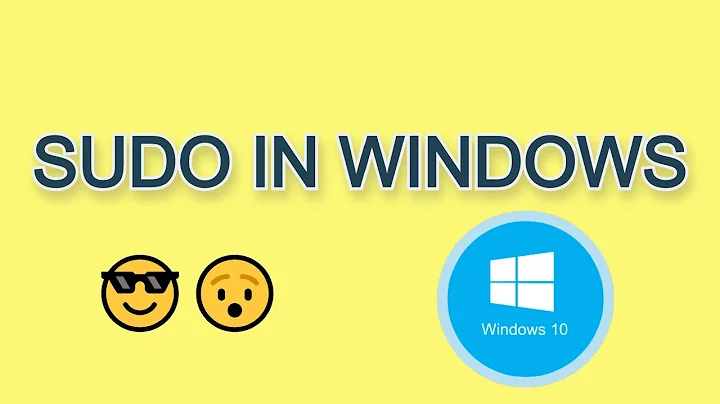Add a sudoer non-interactively from command line
Solution 1
You could use cat to append text to the end of /etc/sudoers. First, make a backup copy of your /etc/sudoers file. Then:
cat >> /etc/sudoers
...type one or more lines here...
[control-D]
Make absolutely sure to use two greater-than characters (>>) and not just one, or else you will overwrite the entire contents of your file.
Solution 2
I had a similar issue trying to get my docker container to allow jenkins scripts to use sudo commands without prompting for a password.
This was solved via the Dockerfile:
RUN echo "jenkins ALL=(ALL) NOPASSWD: ALL" >> /etc/sudoers
Solution 3
To be able to do that, you should make sure you have the following line in your sudoers file:
%sudo ALL=(ALL:ALL) ALL
You can customize the above line to change the permissions just as though %sudo was a user.
That line will allow any users in the sudo group to use sudo.
Now to allow <username> to use sudo, you can just do usermod -a -G sudo <username> as root, which adds <username> to the sudo group.
Solution 4
Here's how I setup a non-root user with the base image of ubuntu:18.04:
RUN \
groupadd -g 999 foo && useradd -u 999 -g foo -G sudo -m -s /bin/bash foo && \
sed -i /etc/sudoers -re 's/^%sudo.*/%sudo ALL=(ALL:ALL) NOPASSWD: ALL/g' && \
sed -i /etc/sudoers -re 's/^root.*/root ALL=(ALL:ALL) NOPASSWD: ALL/g' && \
sed -i /etc/sudoers -re 's/^#includedir.*/## **Removed the include directive** ##"/g' && \
echo "foo ALL=(ALL) NOPASSWD: ALL" >> /etc/sudoers && \
echo "Customized the sudoers file for passwordless access to the foo user!" && \
echo "foo user:"; su - foo -c id
What happens with the above code:
- The user and group
foois created. - The user
foois added to the both thefooandsudogroup. - The
uidandgidis set to the value of999. - The home directory is set to
/home/foo. - The shell is set to
/bin/bash. - The
sedcommand does inline updates to the/etc/sudoersfile to allowfooandrootusers passwordless access to thesudogroup. - The
sedcommand disables the#includedirdirective that would allow any files in subdirectories to override these inline updates.
Solution 5
A common arrangement for appending to files which require privileged access is to use tee. Its primary purpose, of course, is to write to two places, but you can discard one of them and use the side effect that sudo tee -a gives you privileged append.
So, something like
printf 'you ALL=(ALL:ALL) ALL\n' | sudo tee -a /etc/sudoers >/dev/null
I will concur with the comments to add the user to the sudoers group instead to solve this particular problem.
Related videos on Youtube
Roy Truelove
Updated on September 18, 2022Comments
-
Roy Truelove over 1 year
(On Centos through Docker)
I know that I can add a sudoer using
visudo. Is there a way to add a user to the sudoer list straight from the command line, so I don't have to do it interactively?I'm asking because I'm trying to provision my Docker centos container which doesn't play with interactivity.
-
 Alexander Mills over 7 yearshow is this "non-interactively"? and why is this answer accepted?
Alexander Mills over 7 yearshow is this "non-interactively"? and why is this answer accepted? -
 mhucka over 7 yearsThe OP asked for a way to do it from the command line, without using an editor such as
mhucka over 7 yearsThe OP asked for a way to do it from the command line, without using an editor such asvisudo. I believe they meant "interactive" in the sense of using an editor; thus, this is "non-interactive" because this approach does not require an editor. (Obviously, a person will still have to type the user names somehow, so there is no getting around that part.) As for why it was accepted, well, I guess it must have addressed the OP's question well enough that they were satisfied. -
 Alexander Mills over 7 yearsok, to me interactive means anything requiring live user-input. Editor or command line. Semantics I guess. thanks.
Alexander Mills over 7 yearsok, to me interactive means anything requiring live user-input. Editor or command line. Semantics I guess. thanks. -
 mhucka over 7 yearsWhat you say makes sense too – the expression is ambiguous enough that people usually need to say something more to clarify their intentions. I took a guess, but could easily have been wrong. In practical terms, what I wrote above could be written into a script file (e.g., an sh script); what TemporalWolf wrote is what goes into a script file. And honestly, considering that the OP's question was specifically about Docker, I think TemporalWolf's answer might actually be a better one.
mhucka over 7 yearsWhat you say makes sense too – the expression is ambiguous enough that people usually need to say something more to clarify their intentions. I took a guess, but could easily have been wrong. In practical terms, what I wrote above could be written into a script file (e.g., an sh script); what TemporalWolf wrote is what goes into a script file. And honestly, considering that the OP's question was specifically about Docker, I think TemporalWolf's answer might actually be a better one. -
Dessa Simpson about 6 years@AlexanderMills You're right that this is interactive, but it can easily be tweaked to become non-interactive.




